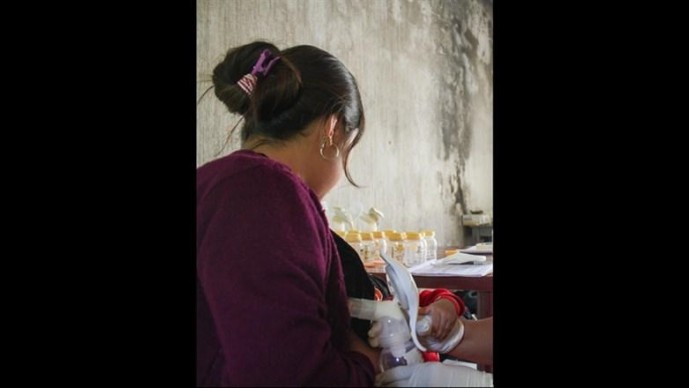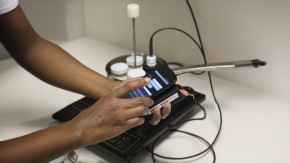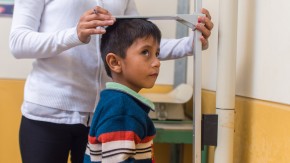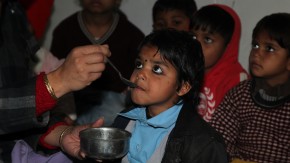Innovation: Understanding Global Differences in Human Milk Nutrients
- Trevor Mundel, Mar 6, 2018

Lindsay Allen, the Director of the USDA Human Nutrition Research Center in Davis, CA might know more about vitamin B12 deficiency than anyone in the world. By now there's not much that surprises her. But Dr. Allen says that – while researching infant nutrition in Guatemala – she figured out that half of the babies in her study got virtually no vitamin B12 from their mothers' milk, and the discovery "freaked me out." She immediately turned her attention to studying breast milk. The Bill & Melinda Gates Foundation is supporting her as she works to make sure that every child gets the best nutrition possible, right from birth.
Breast milk is the gold standard of infant nutrition. It's often called a baby's "first vaccination" because it's full of antibodies, antimicrobial proteins and other factors that protect against disease. For example, breast milk can reduce the risk of diarrheal diseases, which kill half a million young children each year and cause long-term health problems in many more – by a factor of eight. That's why the WHO recommends that mothers feed their babies nothing but breast milk for the first six months of their lives and keep breastmilk in their diets until they're two. Breastfeeding makes babies healthier.
Unfortunately, babies born to malnourished mothers don't get the full benefits of breast milk. And though this may seem like a simple problem, we don't know enough yet to solve it. We don't know, for example, how nutrient levels in breastmilk are related to nutrient levels in babies. We don't even really know what healthy nutrient levels in breastmilk are.
Sure, there are recommended intakes of micronutrients for infants and nursing mothers, but they're based on potentially misleading data. The estimated adequate intake for vitamin A, for example, is based on measurements of milk from six nursing mothers in Arizona. Were these mothers well nourished? Were these levels typical? We have no idea - but Dr. Allen is aiming to find out, in the MILQ study, short for Mothers, Infants and Lactation Quality.
She couldn't launch the study without first developing a method of measuring nutrients and micronutrients in breast milk. That, in itself, was a feat because breast milk isn't like blood - you can't just put it in a centrifuge and spin the serum out to be measured; its composition and matrix is much more complicated. Using mass spectrometry, though, with support from the foundation, Allen and her team came up with a way to measure multiple micronutrients in tiny samples of breastmilk. They also developed the first standard protocols for when and how to gather samples.
Now they've moved on to the next phase of their work, which involves gathering 4,000 samples of breastmilk from a total of 1,000 healthy, well-nourished mothers in four different countries - Brazil, Bangladesh, Denmark, and the Gambia - and measuring its content of macronutrients like protein and fat, as well as 100 different micronutrients and hundreds of bioactive components. They're also measuring micronutrient levels in the mother's blood and the blood of infants nursing on the mother's milk, and they're evaluating the infants' growth and development for nine months after birth.
This will allow Dr. Allen's team to make connections between the nutrient content of breast milk, the nutrient intake and status of the mother, the micronutrient status of infants, and the infants' health. Not only that, but Dr. Allen and her team can begin to establish some reference levels based on solid evidence: What is the normal range of nutrient levels in human milk? How much vitamin B12 does a baby need in milk, and how much B12 does her mother need to consume to make that happen?
These reference levels, along with the methods Dr. Allen developed, will be useful in several ways. People who measure milk nutrients in different settings will be able to see how their values compare with the reference values, in a similar way to how we use growth reference standards. We can develop an accurate picture of which micronutrients tend to be missing from breast milk in various parts of the world, which will help the global health community target the right deficiencies in the right places when designing interventions to fight malnutrition. Also, we can evaluate these interventions much more precisely and know which ones do the most good under which circumstances. Finally, the recommended nutrient intakes of infants and lactating women are based on reported levels in milk, and this study will improve the data.
It's a little bit surprising how poorly we understand something as important as breast milk. Even in wealthy countries where most women are well-nourished, the data on milk composition is poor. The MILQ study will help make sure that children in developing countries reach their full potential. Thanks to Dr. Allen's work, we may be about to crack the case.



